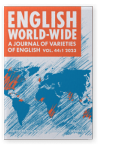Vol. 44:1 (2023) ► pp.1–33
Afrikaans English as a Southern Hemisphere English
Perspectives from a Namibian bilingual dataset
Afrikaans English is seen as connected to White South African English (WSAfE), a Southern Hemisphere English. What makes Afrikaans-speakers’ English varieties distinctly WSAfE or distinctly Afrikaans in a context that has seen much convergence between English and Afrikaans? To answer this question, this study looks at experimental English and Afrikaans phonetic data simultaneously elicited from an informant sample representing three Afrikaans-speaking populations in Namibia, a former dependency of South Africa: the Afrikaners, Basters, and Coloureds. By comparing the informants’ English and Afrikaans vowels, the study establishes that their English varieties display unmistakable WSAfE features, especially found among the Whites, while some of their English vowels co-vary with their nearest Afrikaans equivalents. While generally showcasing the methodological benefits of bilingual data elicitation, the study concludes that postcolonial L2 English varieties are likely to mirror change-in-progress occurring in their historical L1 models, even where access to these models becomes disrupted.
Article outline
- 1.South African English versus Afrikaans English
- 2.Afrikaans and English in Namibia
- 3.Methodology
- 4.Front-to-central monophthongs
- 5.Central-to-back monophthongs
- 6. kit
- 7. face-goat
- 8. mouth-price
- 9.Discussion
- 10.Conclusion
- Notes
-
References
